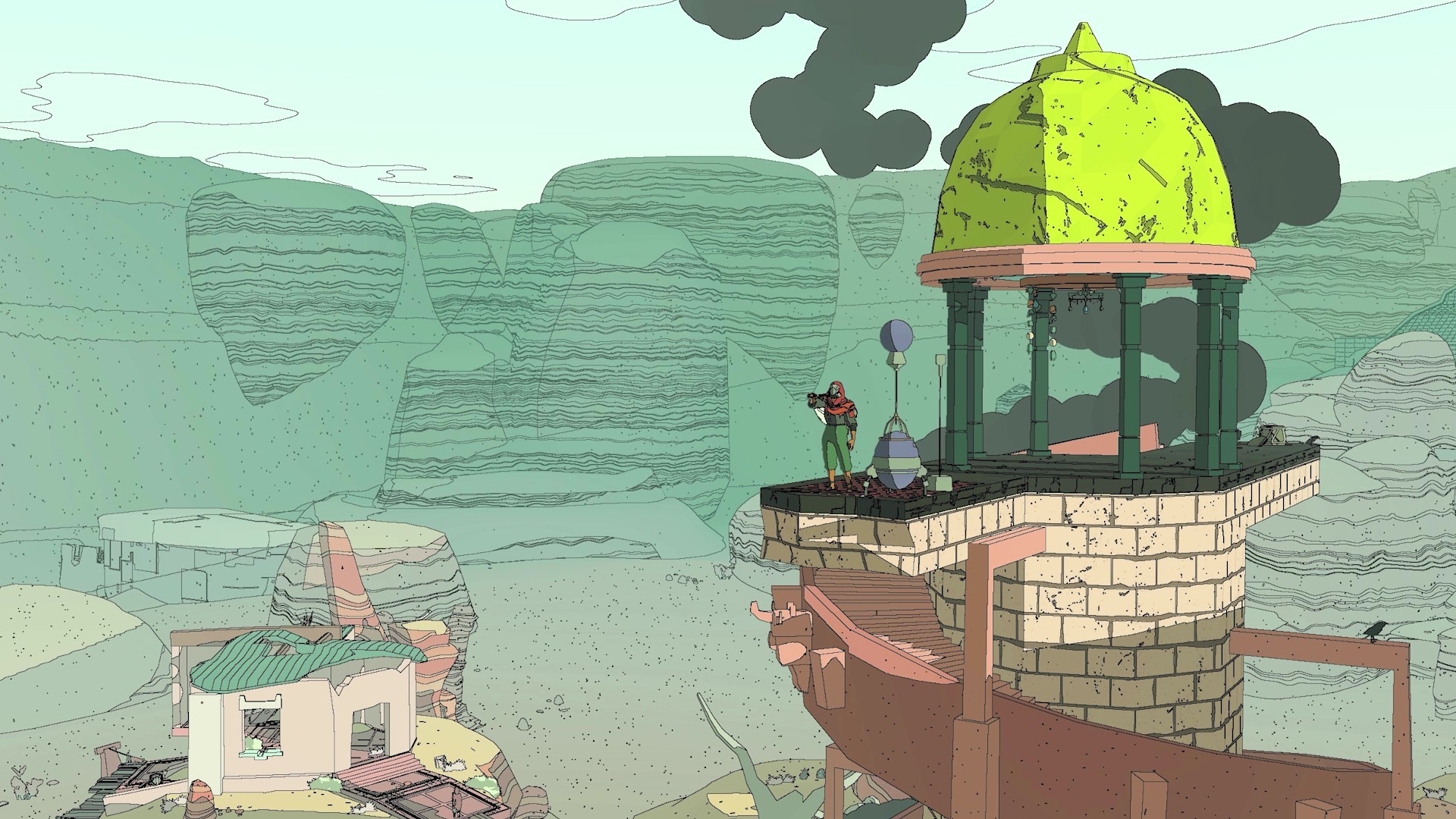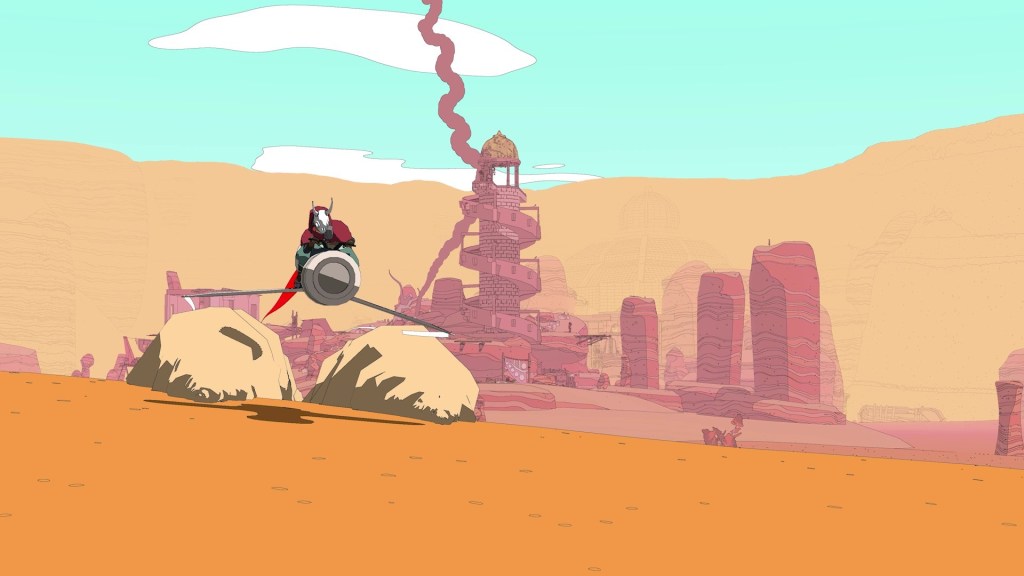Sable lives and dies based on your desire to sit with its landscapes. The desert or the badlands or the pitted canyons constantly stretch out in front of Sable, sitting on her hovering bike, with some prospective goal theoretically out in that distance. This is the game. You’re not supposed to shortcut this. You’re supposed to grab your controller and steel yourself for the minute turns and transformations in the surface of the earth, tracing the contours of the world with your acceleration to prevent yourself from goofily wobbling about in the air. You want to draw a clean line on the surface of things, an arrow at the horizon.
There’s other things around this nearly pure aesthetic, of course. Sable centers on a young woman who is out on an adulthood ritual. No longer a child, she has to strike out from her home and make her way in a world of light danger amidst a set of species who are dotted across a desolate world. The plot is very much a genericized Hero’s Journey by way of a Zelda game, to the extent that I was prepared to have a lot of my experience curbed by that. After all, I don’t care too much for the swordplay and light puzzling of Link’s adventures through the world, and as soon as I was aware of what was up I started to get worried.
Videos by VICE
Those worries were unfounded. Sable has apparently learned some critical lessons about worlds and adventuring from Breath of the Wild, but those lessons happened within a framework that excludes the combat-focused parts of that game. What’s left is the world exploration, climbing, and light questing that dominates Breath, but filtered through a story- and adventuring-first sensibility. That’s a complex way of saying that Sable gives you a world and asks you to go out in it without the presumption that it is trying to kill you. Instead, it wants you to experience it fully, without fear or hesitation. Flipping this focal switch grabbed me in a way that Breath, and the majority of Zelda games, never have.

This light, safe push out into the world neatly aligns with the narrative of Sable’s life out exploring the world. In this science fiction setting, a person is not part of a community until they have gone on a pilgrimage that allows them to experience the vastness of the different communities and opportunities in the world. For that reason, the gameplay of Sable is wonderfully unguided. While the game gets you started with a few quests, the onus is on the player to go out into the world to find people to help, speak with, or meet. The quest does not begin with the direction to kill the big bad at the end of the rainbow. The only thing to do is find yourself, and it begins with picking a direction and simply seeing who is out there.
I found this to be both freeing and frustrating in equal measure. The positive side is that you have to look at your map, determine where you haven’t been, and simply strike out in that direction. Like in Mike Agresta’s Commune Corvidae, an undersung classic in this genre, the act of exploring always seems to produce its own unique reward. Finding outposts or communities consists of looking for road signs and following directions or finding high points and seeking out telltale smoke pillars. Along the way there are goliath pieces of technology that can be explored and “solved” as little micro dungeons, a critical way to learn the history of this world and the people on it. Stumbling on these structures, like the massive crashed colony ship The Whale, can be honestly astounding. Watching a mountain cohere out of the horizon in front of you, and then realizing it is not a mountain, is something that this game does better than any other I’ve ever played.
The frustration kicks in for me when that takes just a little too long. I wandered around in the badlands for a long time before I found someone who would give me a quest. The hoverbike, called a Glider, has an ambivalent enough relationship with the ground that I was having trouble getting it to go up and around some of the game’s more extreme architecture, and I had a solid five minutes of wondering why I was doing any of this shit for so little reward. And then I climbed the back of a dead mechanical giant to harvest lightning crystals from the heart of a storm, something so fresh and strange that the frustration passed. But I can’t forget it.

It’s undeniable that much of my enjoyment of Sable has to do with its aesthetic and narrative sensibilities as much as it has to do with what I am seeing or experiencing narratively. The game reaches for a Moebius look and generally hits the markers. It seems just as influenced by the return to that 1970s and 80s mode of narrative storytelling that has popped up in the last decade in the works of James Stokoe or Parkinson-Morgan’s Kill Six Billion Demons. Its science fiction narrative, with its willingness to proliferate beliefs, practices, and enclaves, is committed to both presenting you with a weird world and the people who make a life within that space. There are people who believe every machine has a mechanical purr that echoes before it and after it in time, metaphysically, and lighting shard collectors who have biologically transformed themselves to better scramble into the clouds. The point is not to solve it or reduce it to familiar structures, even though there is plenty of opportunity to “solve” how this world got to where it is. Instead, the point is merely to live and reflect on what has been lived.
This broad, undirected goal makes for a fulfilling experience. The game has Sable finding her way in the world, and determining who her people are, and that happens through quests and the reward of “badges” that signify association with certain professions. Those badges can be turned into a mask-making creature that will produce a visual representation of Sable’s capability, which means that she could (if she wanted) choose to pursue that life going forward. This experimentation, from place to place and zone to zone, is what Sable is about at its core: doing things and obtaining proof that you have taken their experience in; that you have contemplated them. In a world where games signal their value to you through in-game advertisements and a bombardment of prompts to keep playing, this laconic approach stands out starkly. But any game whose direct mission is to think about the world, and to think about it deeply, should probably have a special place in our heart.
More
From VICE
-

Photo: Whiteland Police Department -

Photo Credit: Infamous PR -

Screenshot: Larian Studios, Reddit -

Screenshot: Sony
